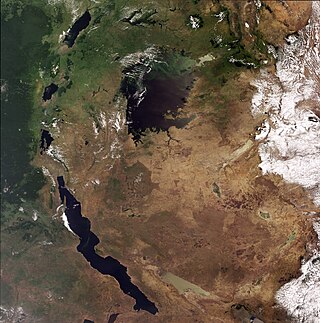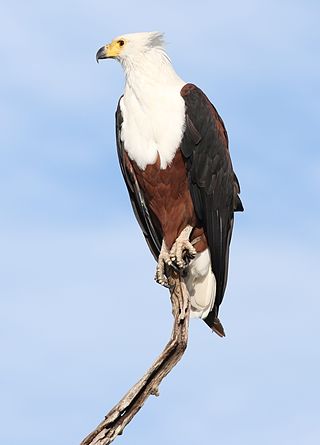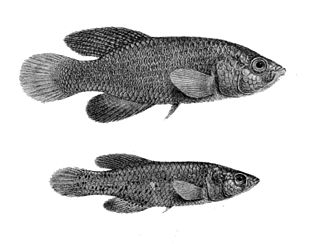
Malawi, officially the Republic of Malawi and formerly known as Nyasaland, is a landlocked country in Southeastern Africa. It is bordered by Zambia to the west, Tanzania to the north and northeast, and Mozambique to the east, south, and southwest. Malawi spans over 118,484 km2 (45,747 sq mi) and has an estimated population of 21,240,689. Malawi's capital and largest city is Lilongwe. Its second-largest is Blantyre, its third-largest is Mzuzu, and its fourth-largest is Zomba, the former capital.

Cichlids are fish from the family Cichlidae in the order Cichliformes. Traditionally Cichlids were classed in a suborder, the Labroidei, along with the wrasses (Labridae), in the order Perciformes, but molecular studies have contradicted this grouping. On the basis of fossil evidence, it first appeared in Argentina during the Early Eocene epoch, about 48.6 million years ago; however, molecular clock estimates have placed the family's origin as far back as 67 million years ago, during the late Cretaceous period. The closest living relative of cichlids is probably the convict blenny, and both families are classified in the 5th edition of Fishes of the World as the two families in the Cichliformes, part of the subseries Ovalentaria. This family is large, diverse, and widely dispersed. At least 1,650 species have been scientifically described, making it one of the largest vertebrate families. New species are discovered annually, and many species remain undescribed. The actual number of species is therefore unknown, with estimates varying between 2,000 and 3,000.

Lake Malawi, also known as Lake Nyasa in Tanzania and Lago Niassa in Mozambique, is an African Great Lake and the southernmost lake in the East African Rift system, located between Malawi, Mozambique and Tanzania.

The African Great Lakes are a series of lakes constituting the part of the Rift Valley lakes in and around the East African Rift. The series includes Lake Victoria, the second-largest freshwater lake in the world by area; Lake Tanganyika, the world's second-largest freshwater lake by volume and depth; Lake Malawi, the world's eighth-largest freshwater lake by area; and Lake Turkana, the world's largest permanent desert lake and the world's largest alkaline lake. Collectively, they contain 31,000 km3 (7,400 cu mi) of water, which is more than either Lake Baikal or the North American Great Lakes. This total constitutes about 25% of the planet's unfrozen surface fresh water. The large rift lakes of Africa are the ancient home of great biodiversity, and 10% of the world's fish species live in this region.

Lake Chilwa is the second-largest lake in Malawi after Lake Malawi. It is in eastern Zomba District, near the border with Mozambique. Approximately 60 km long and 40 km wide, the lake is surrounded by extensive wetlands. There is an island in the middle of the lake called Chisi Island. The lake has no outlet, and the level of water is greatly affected by seasonal rains and summer evaporation. In 1968, the lake disappeared during exceptionally dry weather. When David Livingstone visited the lake in 1859, he reported that its southern boundary reached as far as the Mulanje Massif, which would have made the lake at least 32 kilometres (20 mi) longer than it is today.

Maylandia estherae is a haplochromine cichlid. It is a rock dwelling fish or mbuna from Lake Malawi. This fish, like most cichlids from Lake Malawi, is a mouthbrooder - females hold their fertilized eggs then fry in their mouths until they are released after about 21 days.

Ugali, also known as posho, nsima, papa, pap, sadza, isitshwala, akume, amawe, ewokple, akple, and other names, is a type of corn meal made from maize or corn flour in several African countries: Kenya, Uganda, Tanzania, Zimbabwe, Zambia, Lesotho, Eswatini, Angola, Mozambique, Namibia, Democratic Republic of the Congo, Malawi, Botswana and South Africa, and in West Africa by the Ewes of Togo, Ghana, Benin, Nigeria and Cote D'Ivoire. It is cooked in boiling water or milk until it reaches a stiff or firm dough-like consistency. In 2017, the dish was added to the UNESCO Representative List of the Intangible Cultural Heritage of Humanity, one of a few foods in the list.

The African fish eagle or the African sea eagle is a large species of eagle found throughout sub-Saharan Africa wherever large bodies of open water with an abundant food supply occur. It is the national bird of Malawi, Namibia, Zambia, and Zimbabwe. As a result of its large range, it is known in many languages. Examples of names include: Vis Arend in Afrikaans, nkwazi in Chewa, aigle pêcheur in French, hungwe in Shona, inkwazi in isiZulu, and ntšhu in Northern Sotho. This species may resemble the bald eagle in appearance; though related, the two species occur on different continents, with the bald eagle being resident in North America.

Bottarga is salted, cured fish roe pouch, typically of the grey mullet or the bluefin tuna. The best-known version is produced around the Mediterranean; similar foods are the Japanese karasumi and Taiwanese wuyutsu, which is softer, and Korean eoran, from mullet or freshwater drum. It has many names and is prepared in various ways. Due to its scarcity and involved preparation it is expensive and regarded as a delicacy.

Lake Malawi National Park is a national park at the southern end of Lake Malawi in Malawi, Southeast Africa. It is the only national park in Malawi that was created with the purpose of protecting fish and aquatic habitats. Despite this being its main purpose, Lake Malawi National Park includes a fair amount of land, including a headland, the foreshore and several small rocky islands in Lake Malawi.

Rhamphochromis is a genus of East African haplochromine cichlids endemic to the Lake Malawi basin, also including Lake Malombe, Lake Chilingali, Chia Lagoon and upper Shire River. They mainly occur in offshore open waters, but a few species also near the coast. They are piscivores that typically feed on lake sardines and small utaka cichlids.

Pseudotropheus johannii or the bluegray mbuna is an African freshwater fish from the family Cichlidae.

The wildlife of Malawi is composed of the flora and fauna of the country. Malawi is a landlocked country in southeastern Africa, with Lake Malawi taking up about a third of the country's area. It has around 187 species of mammal, some 648 species of birds have been recorded in the country and around 500 species of fish, many of them endemic, are found in its lakes and rivers. About 20% of the country has been set aside as national parks and game and forest reserves.

The Lake Malawi sardine, lake sardine, or usipa, is an African species of freshwater fish in the family Cyprinidae. It is endemic to Lake Malawi and its outlet, the (upper) Shire River; it is found in Malawi, Mozambique, and Tanzania.

The grey penduline tit, also known as the African penduline-tit, is a species of bird in the family Remizidae. It is found in Angola, Botswana, Burundi, Republic of the Congo, Democratic Republic of the Congo, Eswatini, Kenya, Malawi, Mozambique, Namibia, Rwanda, South Africa, Tanzania, Uganda, Zambia, and Zimbabwe. Its natural habitats are subtropical or tropical dry forests, dry savanna, and moist savanna. At 8 to 9 cm in length and a weight of 6.5 g (0.23 oz), it is one of the smallest species of bird found in Africa, along with its cousin the Cape penduline tit and the perhaps smaller mouse-colored penduline tit and the tit hylia.

The red bush squirrel or red-bellied coast squirrel is a species of rodent in the family Sciuridae, which is found in bush and forest along the eastern seaboard of Africa. It is closely related to P. lucifer, P. vexillarius and P. (p.) vincenti.

D'Anchieta's fruit bat or D'Anchieta's epauletted bat is a species of megabat in the family Pteropodidae. It is the only species in the genus Plerotes. It is found in Angola, Democratic Republic of the Congo, Malawi, and Zambia, where it lives in subtropical or tropical dry forests, dry savanna, and moist savanna.

The spotted killifish is a small, short lived species of fish, an African rivuline from the family Nothobranchiidae. These fish are native to many isolated freshwater pools located in the savannah depressions of east Africa, specifically Malawi, Mozambique, Zimbabwe, and South Africa. This species of fish occurs in ephemeral waters and killifish eggs can survive long periods of dehydration. The word killifish likely comes from the Dutch kil for kill.
Kondowole is a staple of Malawian cuisine that is eaten predominantly in the northern region of Malawi. It is made from cassava flour and water. It is a very sticky meal and resembles that of the Malawian nsima, Tanzanian ugali, or English posho. It is mostly cooked on the floor because of its texture as it is normally tough to run a cooking stick through hence a lot of strength is needed.

Tea and fish are popular features of Malawian cuisine. Sugar, coffee, corn, potatoes, sorghum, cattle and goats are also important components of the cuisine and economy.



















